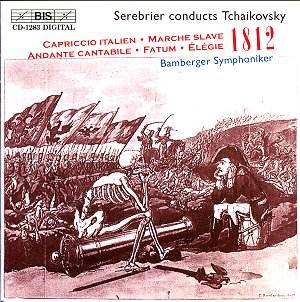This is the second release in this series which
I have heard, and I must say at the outset, that whatever reservations
I might have had about starting yet another Tchaikovsky series,
these releases go from strength to strength.
The present disc contains a clever mixture of
popular and not so popular works of the Russian Master, and this
time, the disc is better filled, playing for 74 minutes. As before
we have performances which I would rate as almost the very best.
They are recorded in first rate up-to-date sound, in a very life
like acoustic, which gives one the idea of the orchestra in the
room.
The orchestra need not worry about comparisons
with the very best. Although it does not show the tonal splendour
of, say, the Berlin Philharmonic, it has a very attractive way
of phrasing these works so that they seem to hang together somewhat
better in competing interpretations. I haven’t enjoyed a Tchaikovsky
concert as much as this for a long time.
Serebrier’s training by Leopold Stokowski, George
Szell and the like shows quite clearly, with all of these works
showing an ebb and flow which sounds quite natural and in no way
contrived.
The earliest work on the disc (if we ignore Tchaikovsky’s
first efforts at Romeo and Juliet) is the symphonic fantasia "Fatum".
If there is a somewhat under-developed lyrical technique displayed
here, Tchaikovsky’s skills are clearly in evidence, showing good,
if not totally inspired tunes plus brilliant orchestration. Perhaps
lacking the ultimate effects of his later works, this fantasy
is a superb example of Tchaikovsky’s art. Although it got off
to a good start, conducted by Anton Rubinstein, the composer,
conductor and audience were all well pleased by the result. A
subsequent performance in St. Petersburg conducted by Balakirev,
was a relative failure, based upon the reaction of audience and
the detailed criticism of the conductor, who was also the dedicatee
of the score. This caused Tchaikovsky to destroy the score, and
Fatum was not performed again until it was resurrected from orchestral
parts long after the composer’s death. The Bambergers play for
all they are worth, with the biggest plus point being that their
enthusiasm in playing counteracts any slight differences in tonal
beauty and ultimate virtuosity when compared with the very best
of a crowded market.
Capriccio italien receives a very good (middle
of the road) performance, and the orchestra plays with much spirit.
This confirms very clearly Tchaikovsky’s high spirits engendered
by an Italian holiday during which he heard many of the themes
used in the work.
In the 1812, the question is usually – "how
are the cannons dealt with." BIS has always been the label
of good taste, and this shows in the 1812. There is no mention
anywhere about which cannons and bells were used in this recording,
unlike some others where pride of place is given to the cannonade.
In this recording, cannons have been, but which cannons and where
from, I am unable to say. Needless to say, BIS makes them contribute
to the proceedings rather than to completely dominate them. I
am sure that we don’t have any of the John Culshaw high jinks
of slowing down a revolver shot to make for me the most realistic
shots ever. That disc (LSO/Alwyn) is currently unavailable and
has never been released on CD. Come on Decca where has this disc
gone?
The remainder of the disc (The Elegie, and the
famous Andante cantabile) is delectable. Well done BIS, Serebrier
and the Bamberg Symphony Orchestra; to say nothing of Tchaikovsky.
If you want this repertoire, this is a very,
very, good disc.
John Phillips

![]() Bamberg Symphony Orchestra/Jose
Serebrier.
Bamberg Symphony Orchestra/Jose
Serebrier.![]() BIS CD-1283 [74’01]
BIS CD-1283 [74’01]